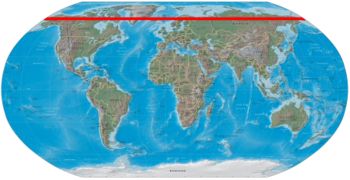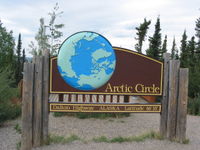Arctic Circle
2007 Schools Wikipedia Selection. Related subjects: General Geography
The Arctic Circle is one of the five major circles of latitude that mark maps of the Earth. This is the parallel of latitude that (in 2000) runs 66 ° 33′ 39″ (or 66.56083 °) north of the Equator. Everything north of this circle is known as the Arctic, and the zone just to the south of this circle is the Northern Temperate Zone.
The Arctic Circle marks the southern extremity of the polar day (24 hour sunlit day) of the summer solstice in June and the polar night (24 hour sunless night) of the winter solstice in December. Within the Arctic Circle, the Sun is above the horizon for 24 continuous hours at least once per year, in conjunction with the Arctic's Summer Solstice - this is often referred to in local vernacular as midnight sun. Likewise, in conjunction with the Arctic’s Winter Solstice, the Arctic sun will be below the horizon for at least 24 continuous hours. (In fact, because of the atmospheric refraction and because the sun appears as a disk and not a point, part of the midnight sun may be seen at the night of the summer solstice up to about 50′ (90 km) south of the geometric arctic circle; similarly, at the day of the winter solstice part of the sun may be seen up to about 50′ north of the geometric arctic circle. This is true at sea level; these limits increase with elevation above sea level, however in mountainous regions there is often no direct view of the horizon.)
The position of the Arctic Circle is determined by the axial tilt (angle) of the polar axis of rotation of the Earth on the ecliptic. This angle is not constant, but has a complex motion determined by many cycles of short to very long periods. At 2000, its mean value was about 23°26′21″. Due to nutation the tilt oscillates over 9″ (about 280 m on the surface) over a period of 18.6 years. The main long-term cycle has a period of 41,000 years and an amplitude of about 0.68°, or 76 km on the surface. Currently the tilt is decreasing by about 0.47″ per year, so the Arctic Circle is moving north by about 15 m per year. Also see precession.
Countries which have significant territory within the Arctic Circle are:
The country of Iceland also has territory within the Arctic Circle, but less than 1 km². This area is on a few small islets, of which only Grímsey (which lies directly on the Arctic Circle) is inhabited.
There are very few people living above the Arctic Circle. The largest towns above the Arctic Circle are Murmansk (population 325,100) in Russia, and Norilsk (135,000) also in Russia. Tromsø in Norway has about 62,000 dwellers, whereas Rovaniemi in Finland has a bit less than 58,000 inhabitants.

